Type 1 diabetes
Page highlights:
How many people are living with type 1 diabetes in Australia?
Around 13,200 children and young adults aged 0–19 were living with type 1 diabetes in 2021.
The prevalence of type 1 diabetes in 2021 was similar among males and females.
Type 1 diabetes prevalence rates remained stable between 2014 and 2021.
How many people are newly diagnosed with type 1 diabetes in Australia?
Males were 1.3 times as likely to be newly diagnosed (incidence) with type 1 diabetes as females in 2021.
Type 1 diabetes incidence rates were highest in the 10–14 age group, for both males and females.
Type 1 diabetes incidence rates remained relatively stable between 2000 and 2021.
How many people are living with type 1 diabetes in Australia?
There are currently no accurate national data on the total number of cases (prevalence) of type 1 diabetes at all ages (see Why is prevalence only reported for children and young adults with type 1 diabetes?) However, the National (insulin-treated) Diabetes Register (NDR) can provide reliable estimates for children and young adults. According to the NDR, around 13,200 children and young adults aged 0–19 were living with type 1 diabetes in 2021 (211 per 100,000 population).
Variation by age and sex
In 2021:
- the prevalence of type 1 diabetes was similar among males and females
- the majority (81%) of children and young adults with type 1 diabetes were aged 10–19
- the type 1 diabetes prevalence rate was around 15 times as high in children and young adults aged 15–19 as those aged 0–4 (416 and 27 per 100,000 population, respectively) (Figure 1).
Figure 1: Prevalence of type 1 diabetes in children and young adults, by age and sex, 2021
The bar chart shows the prevalence of type 1 diabetes in children and young adults by sex in 2021. Rates were highest among males and females aged 15–19 (412 and 404 per 100,000 population, respectively).
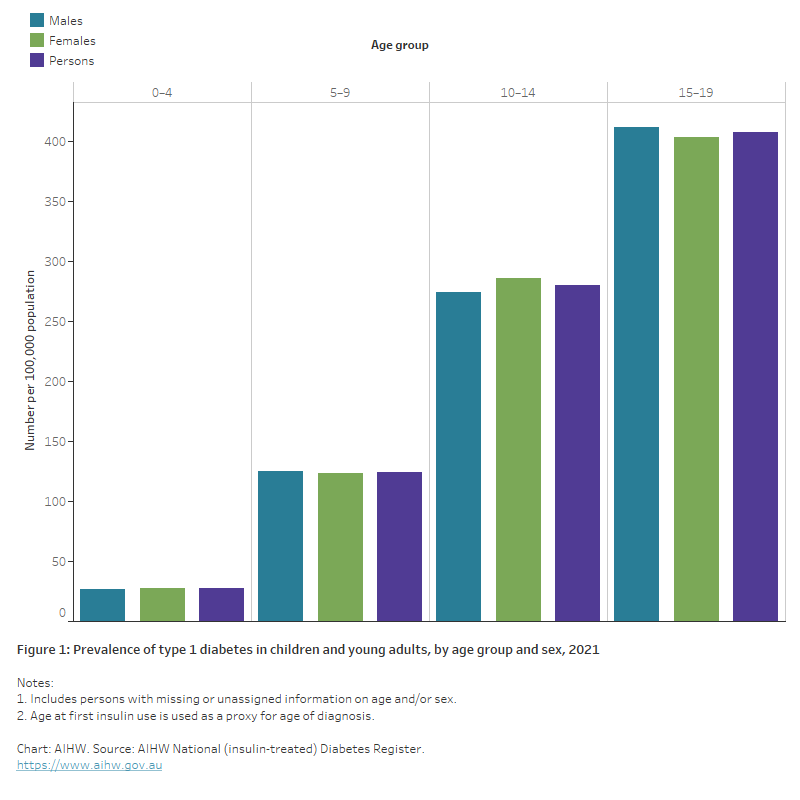
Trends over time
The age-standardised prevalence rates for type 1 diabetes among children and young adults remained relatively unchanged between 2014 and 2021 (Figure 2).
Figure 2: Prevalence of type 1 diabetes in children and young adults, by sex, 2014–2021
The chart shows the age-standardised rates of young males and females living with type 1 diabetes, which have remained largely unchanged between 2014 to 2021.
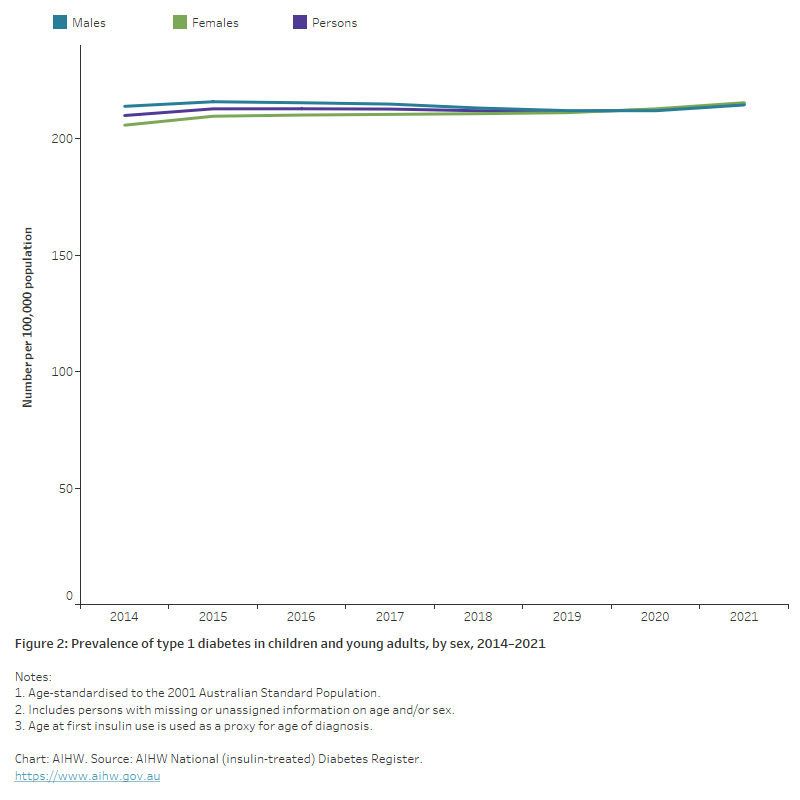
Variation between population groups
Aboriginal and Torres Strait Islander people
In 2021, there were 587 Aboriginal and Torres Strait Islander children and young adults aged 0–19 living with type 1 diabetes (158 per 100,000 population).
After adjusting for differences in the age structure of the populations, Indigenous children and young adults were around 21% less likely to be living with type 1 diabetes as their non-Indigenous counterparts (Figure 3).
Remoteness area
There was no clear pattern between the prevalence of type 1 diabetes among children and young adults and remoteness area in 2021. Overall, rates were highest in Inner regional and lowest in Remote and very remote areas (Figure 3).
Socioeconomic area
The prevalence of type 1 diabetes among children and young adults varied across socioeconomic areas in 2021, with rates being 1.2 times as high among the most disadvantaged areas compared with the least disadvantaged areas (Figure 3).
Figure 3: Prevalence of type 1 diabetes in children and young adults (0–19 years), by selected population group and sex, 2021
The horizontal bar chart shows that male and female type 1 diabetes prevalence rates in 2021, were lower among younger Indigenous Australians, younger people living in Remote and very remote areas, and younger people living in the least disadvantaged socioeconomic areas.
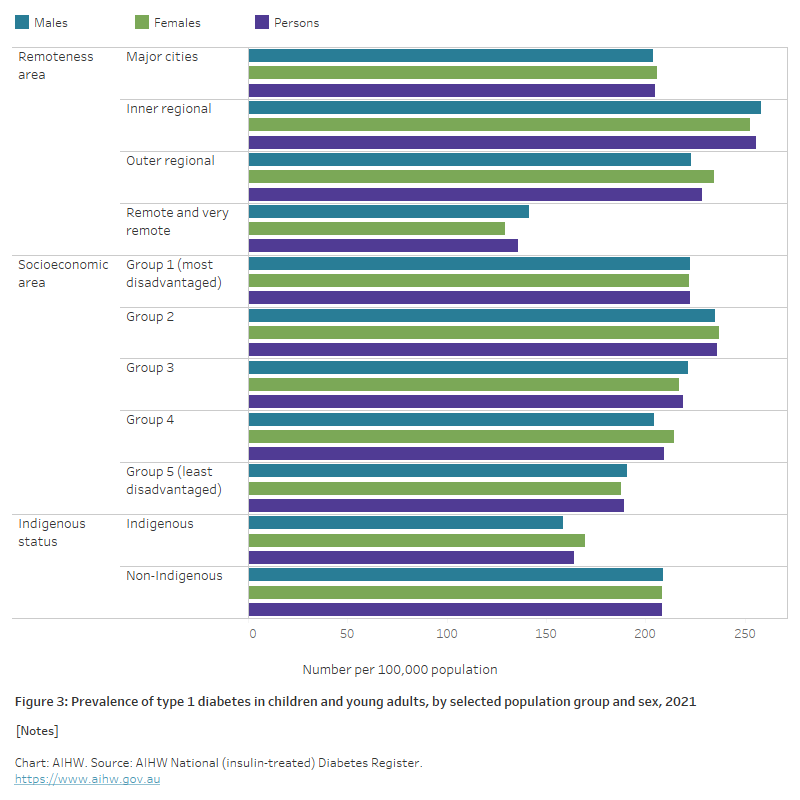
Country of birth
Type 1 diabetes prevalence rates varied by country of birth. In 2021, age-standardised rates were 1.8 times as high among children and young adults born in North–West Europe as those born in Australia (Figure 4). Caution should be used when interpreting these data due to a high level of missing country of birth information for people on the linked NDSS and APEG data.
Figure 4: Prevalence of type 1 diabetes in children and young adults (0–19 years), by country of birth, 2021
The horizontal bar chart shows type 1 diabetes prevalence rates were highest among children and young adults born in North-West Europe with prevalence rates 1.8 times as high as those among children and young people born in Australia (271 and 148 per 100,000 population).
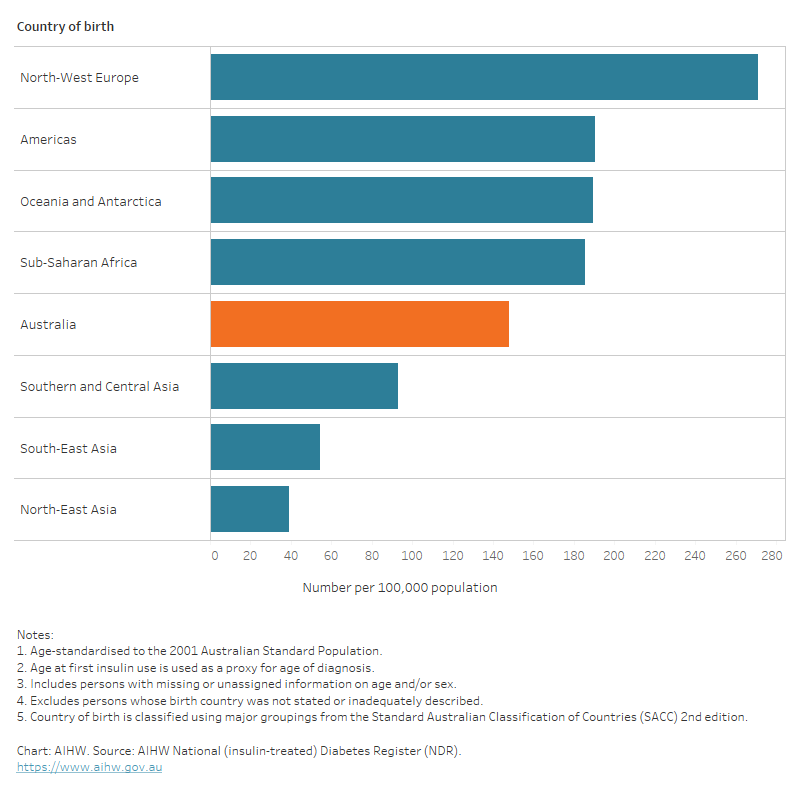
Why is prevalence only reported for children and young adults with type 1 diabetes?
The NDSS registration forms and database have changed over time.
- Information recorded for older registrants is frequently incomplete for important variables, including diagnosis date and the date of first insulin use.
- The largest change occurred progressively between 2 December 2002 and 28 February 2003. At this time, the clinical terminology used to describe diabetes type was updated from juvenile-onset diabetes, Insulin Dependent Diabetes Mellitus (IDDM) and Non-Insulin Dependent Diabetes Mellitus (NIDDM), to type 1 and type 2 diabetes. Prior to this, people registering with the NDSS with insulin-treated type 2 diabetes may have been incorrectly recorded as type 1 so that their insulin using needs could be met. This occurred because the NDSS registration form did not have an option for insulin-treated type 2 diabetes, reflecting diabetes classification at that time. All registrants that were classified as IDDM were reclassified as type 1 diabetes as there was no effective way to differentiate between diabetes types, resulting in misclassification for some people with insulin-treated type 2 diabetes.
- In 2015, Diabetes Australia commissioned the Australian Healthcare Associates (AHA) to conduct an audit to test the reliability of the NDSS database and determine whether diabetes type is correctly recorded. Almost 1 in 5 (17.9%) of people surveyed with reported type 1 diabetes were found to have type 2 diabetes (25 of 140), with 80% of these people initially registered prior to 2003 (20 of 25) (AHA 2015). Small numbers of individuals with reported type 2 diabetes were also found to be misclassified (23 of 695).
- The NDR uses NDSS data linked with the Australasian Paediatric Endocrine Group (APEG) state-based registries which is used as a secondary ascertainment dataset and a rigorous algorithm is applied to confirm diabetes type. The algorithm checks age at diagnosis and the period between diagnosis and first insulin use. These factors are important for confirming type 1 diabetes status due to younger diagnosis age and immediate requirement for insulin therapy for survival in type 1 diabetes. The validation undertaken for the NDR, as well as the use of a secondary ascertainment data source, provide confidence in the accuracy of diabetes type for younger Australians.
- The Australian Bureau of Statistics National Health Survey also provides national estimates for type 1 diabetes. However, small numbers for younger age groups results in high variability and limits the reporting that is possible on people living with type 1 diabetes. Further, survey questions relating to diabetes include ‘Diabetes – type 1 – (insulin dependent)’ as the type 1 diabetes option, which may result in incorrect selection for people with type 2 diabetes using insulin.
How many people are newly diagnosed with type 1 diabetes in Australia?
Around 58,600 people were newly diagnosed with type 1 diabetes between 2000 and 2021 according to the National (insulin-treated) Diabetes Register (NDR). This was around 2,700 new cases of type 1 diabetes each year – an average of 7 newly diagnosed people a day.
There were 3,000 people newly diagnosed (incidence) with type 1 diabetes in Australia in 2021, equating to 12 diagnoses per 100,000 population.
Variation by age and sex
In 2021:
- nearly 2 in 3 people newly diagnosed with type 1 diabetes were aged under 30
- incidence rates were highest in the 10–14 age group for both males and females, 36 and 31 per 100,000, respectively (Figure 5)
- after adjusting for differences in the age structure of the populations, type 1 diabetes incidence rates were 1.3 times as high among males as females.
Figure 5: Incidence of type 1 diabetes, by age and sex, 2021
The butterfly chart shows the incidence rates of type 1 diabetes by age group in 2021. Rates were highest among males and females aged 10–14 years (36 and 31 per 100,000 population).
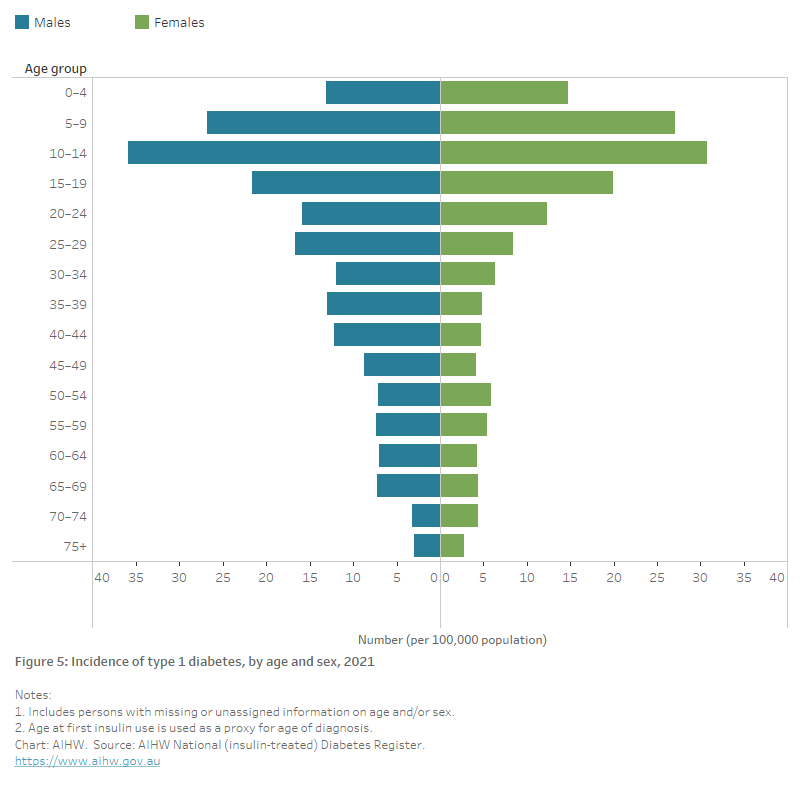
The chart shows the age-standardised incidence rates for males and females newly diagnosed with type 1 diabetes between 2000 to 2021. Over the last two decades, incidence rates have remained relatively stable, fluctuating between 13 and 15 new cases per 100,000 population for males and 10 to 12 new cases for females.
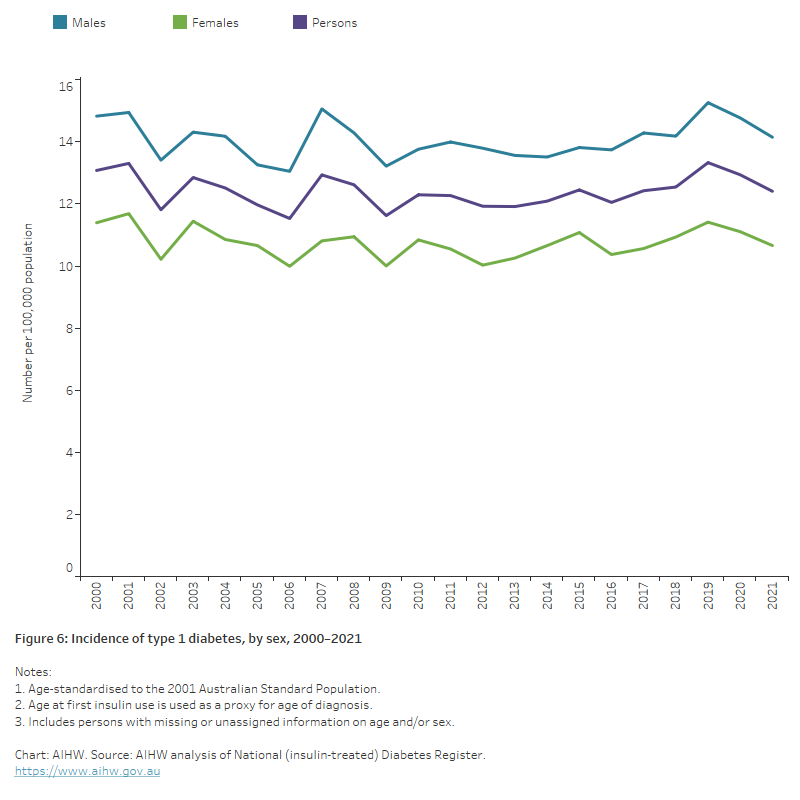
Variation between population groups
Aboriginal and Torres Strait Islander people
There were 151 Aboriginal and Torres Strait Islander people newly diagnosed with type 1 diabetes in 2021 (17 per 100,000 population). Age-standardised incidence rates were 1.3 times as high among Indigenous males compared with Indigenous females.
After adjusting for differences in the age structure of the populations, the type 1 diabetes incidence rate was 1.2 times as high among Indigenous Australians compared with non-Indigenous Australians (Figure 7).
Remoteness area
In 2021, type 1 diabetes incidence rates were lowest in Remote and very remote areas and highest in Inner regional areas (Figure 7).
Socioeconomic area
The incidence of type 1 diabetes in 2021 was slightly lower in the least disadvantaged socioeconomic areas, but similar across the other areas (Figure 7).
Figure 7: Incidence of type 1 diabetes, by selected population groups and sex, 2021
The chart shows that male and female type 1 diabetes prevalence rates in 2021, were higher among Indigenous Australians, people living in Inner and Outer regional areas, and people living in the lowest socioeconomic areas.
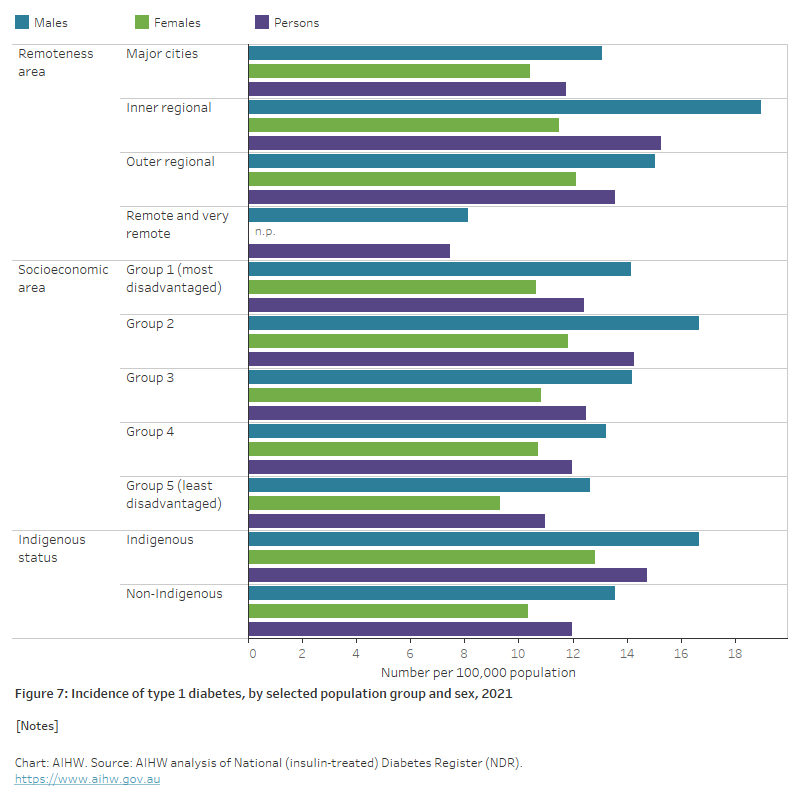
References
Australian Healthcare Associates (AHA) (2015) NDSS Registrant Details Audit Final Report for Diabetes Australia, AHA, Melbourne.


